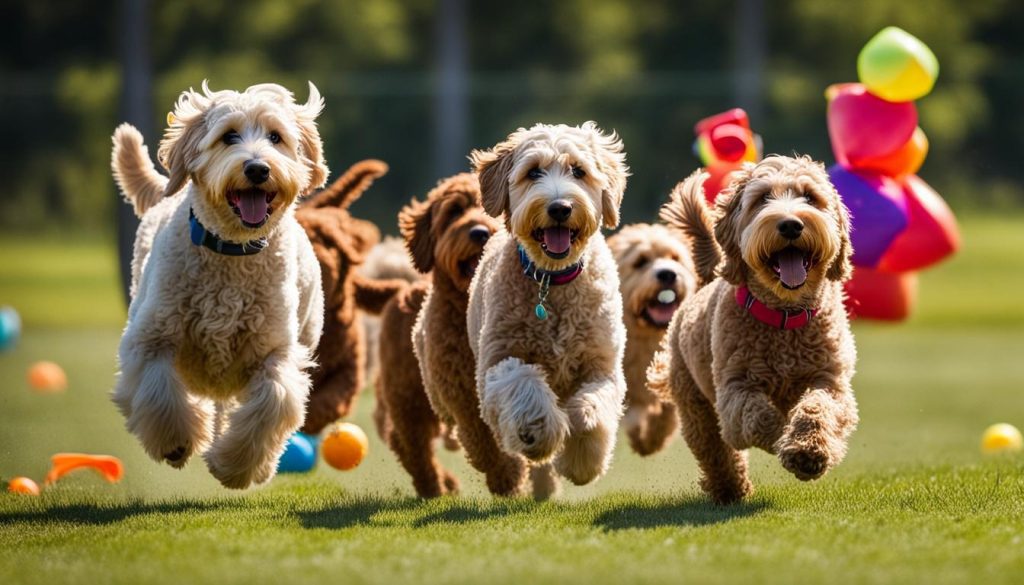Welcome to my guide on Labradoodle training! Labradoodles are wonderful family pets known for their temperament, low shedding, and affectionate nature. Training your Labradoodle from a young age is essential to ensure they grow up to be well-behaved and happy. In this section, I will provide you with essential tips and insights for successful Labradoodle training.
Labradoodle Training
- Start training your Labradoodle as soon as you bring them home.
- Use positive reinforcement and rewards to motivate your Labradoodle during training sessions.
- Keep training sessions short and fun for both you and your Labradoodle.
- Socialize your Labradoodle to new experiences, people, and environments to build their confidence.
- Consistency and patience are key in Labradoodle training.
Now that you understand the importance of training and the key takeaways, let’s delve into the details of Labradoodle training in the following sections.
The Importance of Early Training
Starting training early is crucial for Labradoodle puppies. They are more receptive to learning at a young age and can form positive associations with training.
Positive reinforcement is a powerful tool in Labradoodle training. By using treats, praise, and affection, you can encourage your puppy to learn and obey commands. Consistency is also key – using the same commands and cues every time helps reinforce their understanding.
Short and sweet training sessions, about 5-10 minutes several times a day, are ideal for puppies with short attention spans. It’s important to keep the training sessions fun and engaging for both you and your Labradoodle.
Potty training is one of the most important aspects of early Labradoodle training. Starting early helps establish good habits and prevent accidents in the house. Consistently using a designated area and rewarding successful potty breaks with praise or treats will help your puppy learn quickly.
Basic commands like “come,” “sit,” “stay,” and “heel” form the foundation for more advanced training. Mastering these commands helps build a strong bond between you and your Labradoodle and sets the stage for a well-behaved and obedient companion.
Socialization and Training Techniques
Socialization plays a crucial role in the training of Labradoodle puppies. It is essential to introduce them to new people, places, and experiences in a positive and controlled manner. By doing so, we can help them grow into confident and well-behaved dogs.
One effective technique for socialization is exposing them to various situations and people, which will prepare them for different environments. This can be achieved through training exercises such as scent trails, where they learn to follow specific scents, and inviting friends over to interact with them.
Additionally, practicing recall and leash walking are important components of Labradoodle training. Recall training helps them learn to come back to you when called, ensuring their safety in various situations. Leash walking teaches them to walk calmly and obediently by your side, making walks enjoyable for both of you.
Building confidence in Labradoodles is vital. Exposing them to different experiences and environments will help them become well-rounded and sociable dogs. Positive reinforcement is key in this process. By rewarding their brave and calm behavior, we reinforce their confidence and encourage them to continue exploring new things.
To illustrate the positive impact of socialization and training techniques, let’s take an example from our labradoodle training program:
I introduced my Labradoodle puppy, Max, to different environments gradually. We started by taking short walks in our quiet neighborhood, where Max could observe the sights and sounds. As he grew more comfortable, we ventured to busier places like parks and pet-friendly stores.
I also made sure Max had positive encounters with people of all ages and different pets. I invited friends over, allowing Max to interact with them in a controlled environment. We practiced recall exercises in a fenced yard, which helped build his confidence and improved his obedience to commands.
During our outings, I used reward-based training techniques to reinforce his good behavior. I praised and rewarded him with treats when he approached new situations calmly and confidently. This encouraged Max to adapt quickly to new experiences and helped him become more sociable.

Labradoodle socialization training and effective training techniques, such as introducing new experiences and building confidence, are crucial for raising a well-adjusted and obedient furry companion.
Training Milestones by Week
Training your Labradoodle puppy is an exciting journey that brings you closer to your furry friend. Each week presents new opportunities for growth and learning. Let’s explore the training milestones you can expect to achieve with your Labradoodle puppy over the course of several weeks.
Week 1: Building the Foundation
- Introduce your puppy to the yard and let them explore different surfaces.
- Teach them their name, sit, recall, retrieve, sleep training, and potty training.
- Introduce alone training, helping them feel comfortable being left alone for short periods.
Week 2: Expanding Socialization
- Continue socialization exercises by allowing your puppy to watch the world go by outside the house.
- Engage in playful activities like playing dress-up, introducing different sights and sounds.
- Focus on crate training, alone training, potty training, recall, fetch, and leash walking.
Week 3: Exploring New Experiences
- Include scent trails and short drives in your puppy’s socialization routine.
- Continue training with recall, encouraging your puppy to come when called.
- Teach them to keep all four paws on the floor, practice the “down” command, and generalize their training to various environments.
Week 4: Socialization with Others
- Arrange a controlled meeting with another friendly dog to promote positive socialization.
- Find a reputable puppy class where your Labradoodle can interact with other pups and learn valuable social skills.
- Focus on settling on a mat, leash walking, recall games, and getting your puppy accustomed to grooming sensitive areas.
By following this Labradoodle puppy training schedule, you can set achievable weekly goals and celebrate the milestones your pup reaches along the way. Remember, training is as much about building a strong bond with your Labradoodle as it is about obedience. Keep the sessions fun, positive, and filled with love!
Essential Tips for Goldendoodle and Labradoodle Training
When it comes to training your Goldendoodle or Labradoodle, understanding canine learning theory and adopting effective training methods are key. Here are some essential tips to help you in your training journey:
Prepare Your Home and Schedule
Before bringing your new Goldendoodle or Labradoodle puppy home, make sure you have prepared your living space to provide a safe environment. Remove any potential hazards, secure electrical cords, and provide designated areas for eating, sleeping, and playing. Additionally, set aside dedicated time in your schedule for training sessions and daily exercise to meet your doodle’s mental and physical needs.
Forming a Bond and Gaining Trust
Building a strong bond with your Goldendoodle or Labradoodle is crucial for successful training. Spend quality time together, engage in play sessions, and offer plenty of positive reinforcement, such as treats and praise. By earning their trust, your doodle will be more motivated to learn and please you throughout the training process.
Obedience Training with Positive Reinforcement
Positive reinforcement is a highly effective training method for Goldendoodles and Labradoodles. Use treats, verbal praise, and clicker training to reward good behavior and discourage unwanted actions. This positive approach helps your doodle associate training with positive experiences and encourages them to repeat desirable behaviors.
Teach the Basics
Start your training journey by teaching your Goldendoodle or Labradoodle the basics. Focus on potty training, crate training, socialization, and essential manners. A solid foundation in these areas will pave the way for more advanced training in the future. Be patient and consistent in your approach, and remember that each doodle learns at their own pace.
Consistency is Key
Consistency is vital when training Goldendoodles and Labradoodles. Use the same commands and cues consistently, and establish clear expectations for your doodle’s behavior. Maintaining a regular routine and providing clear guidelines will help your doodle understand what is expected of them and reduce confusion during training.

By following these essential tips, you can set your Goldendoodle or Labradoodle up for success in their training journey. Remember to be patient, maintain a positive attitude, and celebrate every milestone with your furry friend. With dedication and consistency, you can have a well-behaved and happy doodle by your side.
Training Tips for Goldendoodle and Labradoodle Puppies
When it comes to training Goldendoodle and Labradoodle puppies, there are several important activities to focus on. These include potty training, crate training, socialization exercises, manners, and establishing a routine. Let’s dive into each of these training aspects:
Potty Training
Potty training is an essential skill to teach your Goldendoodle or Labradoodle puppy. Consistency is key in this process. Establish a designated potty area and take your puppy there frequently, especially after meals and naps. Remember to reward and praise them when they successfully eliminate in the right spot. This positive reinforcement will help reinforce the desired behavior.
Crate Training
Crate training provides your puppy with a safe and comfortable space of their own. Introduce the crate gradually, using positive reinforcement to create a positive association. Make sure the crate is appropriately sized, allowing enough room for your puppy to stand, turn around, and lie down. Use treats and toys to make the crate a pleasant place for them to be. Over time, they will learn to see it as their den.
Socialization Exercises
Socialization is crucial for Goldendoodle and Labradoodle puppies to become well-rounded and confident dogs. Expose them to various people, animals, environments, and sounds in a controlled and positive way. Take them on walks, introduce them to friendly dogs, and invite guests to your home. This exposure will help them develop good social skills and reduce the likelihood of fear-based behaviors.
Manners
Teaching good manners to puppies is essential for their integration into your family and society. Start early by training them to sit, stay, and come when called. Use positive reinforcement techniques like treats and praise to reward desired behaviors. Additionally, work on managing biting behaviors by redirecting their attention to appropriate chew toys.
Establishing a Routine
Creating a routine helps your Goldendoodle or Labradoodle puppy feel secure and establishes structure in their daily life. Set regular feeding times, play sessions, exercise periods, and rest times. Consistency and predictability in their routine will make them more comfortable and help prevent behavioral issues.
Patience and Positive Reinforcement
Throughout the training process, remember to be patient with your puppy. Training takes time and repetition, so stay consistent and avoid becoming frustrated. Always use positive reinforcement, such as treats, praise, and play, to reward and encourage desired behaviors. This positive approach will create a strong bond between you and your puppy and make training enjoyable for both of you.
By focusing on these training activities, you can set your Goldendoodle or Labradoodle puppy up for success in their development and behavior. Remember to be patient, consistent, and positive in your approach. With time and dedication, you’ll have a well-trained and joyful companion by your side.
Conclusion
Labradoodle training is a journey that begins early and requires dedication and consistency. By following the tips and techniques outlined in this guide, you can ensure that your Labradoodle puppy grows up to be a well-behaved and joyful companion.
Starting training early is crucial for Labradoodles, as they are highly receptive to learning at a young age. Positive reinforcement, such as treats, praise, and affection, is an effective method for training. Consistency in using commands and cues is essential for building a strong foundation.
Remember to keep training sessions short, about 5-10 minutes several times a day, to cater to your Labradoodle’s short attention span. Prioritize socialization to help your pup develop confidence and adaptability in various environments. Basic obedience commands lay the groundwork for advanced training and strengthen the bond between you and your furry friend.
With patience and a positive approach, Labradoodle training can be a rewarding experience. By investing the time and effort, you can enjoy the company of a well-trained Labradoodle that brings joy and happiness to your family.
FAQ
When should I start training my Labradoodle?
Training should start as soon as you bring your Labradoodle home, as they are like sponges at a young age.
What supplies do I need for Labradoodle training?
You will need a pouch or container for treats, a soft collar with a name tag, a harness, a 2-meter training leash, a mat or piece of vet bed for settling, training treats, two identical toys for swaps, a soft brush for grooming, and a crate and playpen for comfort and containment.
What are Labradoodles bred for?
Labradoodles were first bred in 1988 as hypoallergenic guide dogs by crossing Labradors and Poodles. Labradors were bred for retrieving, while Poodles were bred for hunting ducks.
How long should training sessions be?
Training sessions should be kept short, about 5-10 minutes, several times a day, to accommodate puppies’ short attention spans. It’s important to end on a high note and make training fun for both you and your Labradoodle.
What are some basic commands to teach a Labradoodle?
Some basic commands to teach a Labradoodle include “come,” “sit,” “stay,” and “heel.” These commands form the foundation for more advanced training and help build a strong bond between you and your Labradoodle.
How important is socialization for Labradoodle puppies?
Socialization is crucial for Labradoodle puppies. Introduce them to new people, places, and experiences in a positive and controlled manner. This helps them grow into confident and well-behaved dogs.
What are some training activities for Labradoodles?
Training activities for Labradoodles include potty training, crate training, leash walking, recall, and general manners. These activities help establish a routine, build trust, and teach basic skills.
What is the importance of positive reinforcement in Labradoodle training?
Positive reinforcement, using treats, praise, and affection, is a powerful tool in Labradoodle training. It helps motivate and reward desired behaviors, making the training experience enjoyable for both you and your Labradoodle.
How can I ensure my Labradoodle becomes a well-behaved companion?
By starting training early, using positive reinforcement, being consistent, prioritizing socialization and basic obedience, and dedicating time and effort to training, you can ensure that your Labradoodle becomes a well-behaved and joyful companion.






